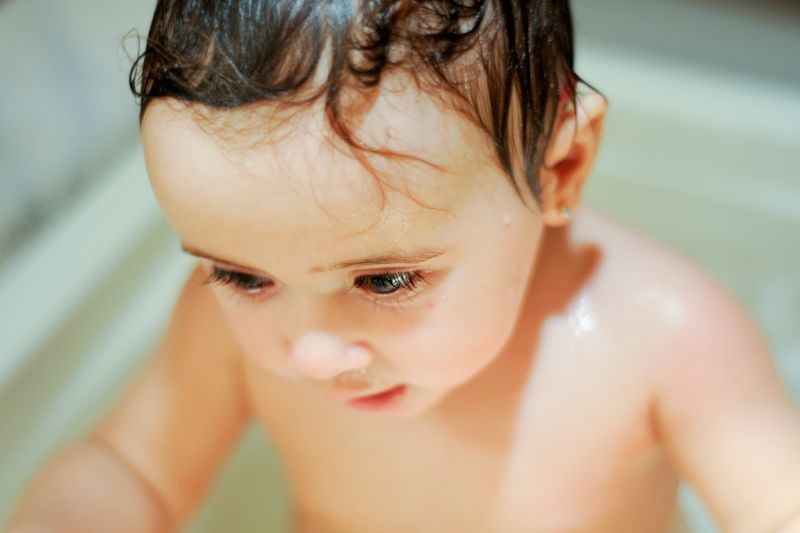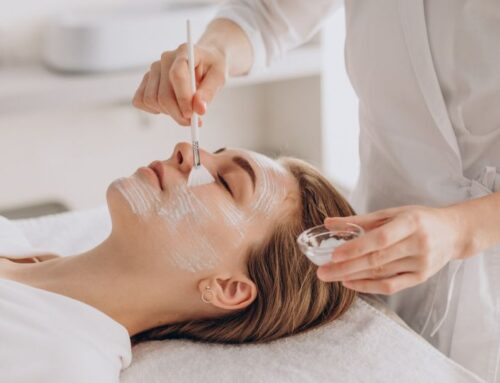Babies need utmost care and love. So do their skin and hair. So, it requires special care when it comes to skin and hair care.

Understand Baby’s Skin
Baby skin is delicate. Anyone looking at them can see soft, fragile skin known for rose-leaf softness. During their first two years of life, their skin undergoes many changes. Newborns have a relatively high skin pH level (much closer to neutral pH=7). This means a newborn baby’s skin lacks the acid mantle, which protects a baby’s gentle skin. It takes up to three months to develop completely. Compared to adult skin, the structure of the baby’s skin is different and 30% more delicate than adults. Until age two, babies have an immature moisture barrier that is easily prone to damage. Baby skin also retains and loses water at a faster rate (a process called trans-epidermal water loss-TEWL).
Baby & Kid Skin and Hair Care
1. Start cleansing with a sponge bath

Stick to quick sponge baths until the umbilical cord falls off, which could take a week or more. The sponge bath lets you avoid submerging the cord stump, which needs to stay dry. Your baby will be ready for a proper bath when the cord has fallen off.
2. Switch to a traditional bath
When bathing your baby, use lukewarm water and mild, fragrance-free baby soap or baby wash and shampoo. Take soap or wash and lather between your palms and apply to dirty areas while gently scrubbing between all those cute baby creases, under the chin, behind ears, the diaper area, and even between those teeny tiny fingers & toes where debris often collects. And rinse off after cleaning. Consider tear-free, pH-balanced, hypoallergic, and dermatologically tested soap baby wash and shampoo that are gentle on baby’s delicate skin, scalp, and hair, minimizing sensitivities. You don’t need to bathe babies every day but regularly.
3. Cradle cap
A common skin condition that causes crusty or oily scaly patches on the scalp or sometimes on their torsos and body folds when babies are between 2 weeks and 12 months old. In most cases, the cradle cap will clear up on its own in weeks or a few months. Home care measures include applying emollient such as coconut or mineral oil to soften before bath and washing head and scalp with baby shampoo. Don’t scratch the cradle cap. If you don’t see improvements, seek advice from your doctor.
4. Avoid diaper rashes and contact dermatitis triggers
Diaper rash is a form of irritated skin (dermatitis) that can make a baby’s skin sore, red, scaly, and tender when they sit too long in a soiled diaper. In most cases, it clears up with simple changes in diapering. Change dirty diapers as soon as possible to prevent diaper rash. If a diaper rash develops, be gentle when cleaning the area and apply a diaper cream containing zinc oxide. Wash baby blankets, sheets, and clothing using fragrance-free detergents to remove common allergens and irritants such as saliva and urine. If you not sure what caused the reaction, consult your child’s doctor.
5. Dry skin
A healthy skin barrier prevents the skin from becoming dry and dehydrated while keeping irritants and pollutants out. Babies with dry skin have compromised a barrier. You can apply emollient-rich plant oils, such as olive, coconut, sunflower seed oils, or petroleum-jelly-based products if your baby has very dry or cracking skin. These moisturizing should be free of fragrance and dyes, which can irritate the baby’s skin even more.
6. Heat rash
Also known as prickly heat and miliaria occurs when sweat is trapped in the skin and can’t expel sweat. Heat rash is common in newborns in the first weeks of life as their sweat glands aren’t fully developed. It happens most often when the weather is hot or humid. A cool bath can help alleviate any itchiness and clear the rash. And avoid oil-based products that block pores. Contact your child’s doctor if the inflammation does not improve within three days, if the skin looks infected, or if your baby develops a fever of 100°F or above.
7. Shield your baby from the sun
Limit the exposure to the sun between 10 a.m. and 4 p.m. when UV rays are strongest. Shade is the best way to protect your baby from the sun. If you can’t find shade, put your baby in a wide-brimmed hat that covers the neck & ears and dress your baby in sun-protective loose-fitting, lightweight clothing and sunglasses with UV protection. Sunscreen lotion is not recommended to babies below 6 months. Much older children apply sunscreen with an SPF of at least 15.
8. Watch nails growth
File or trim your baby’s nails weekly or more often to prevent scratches



